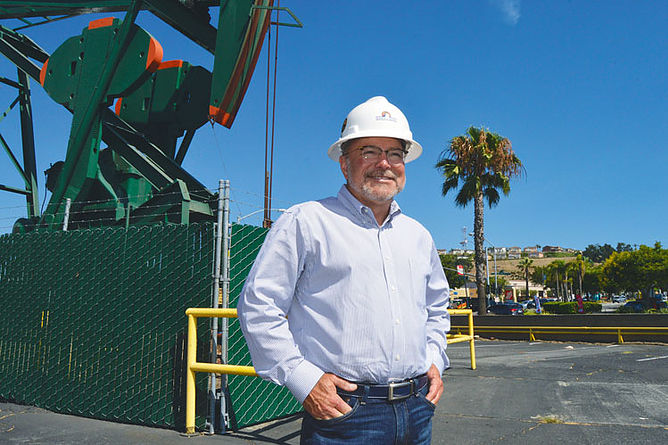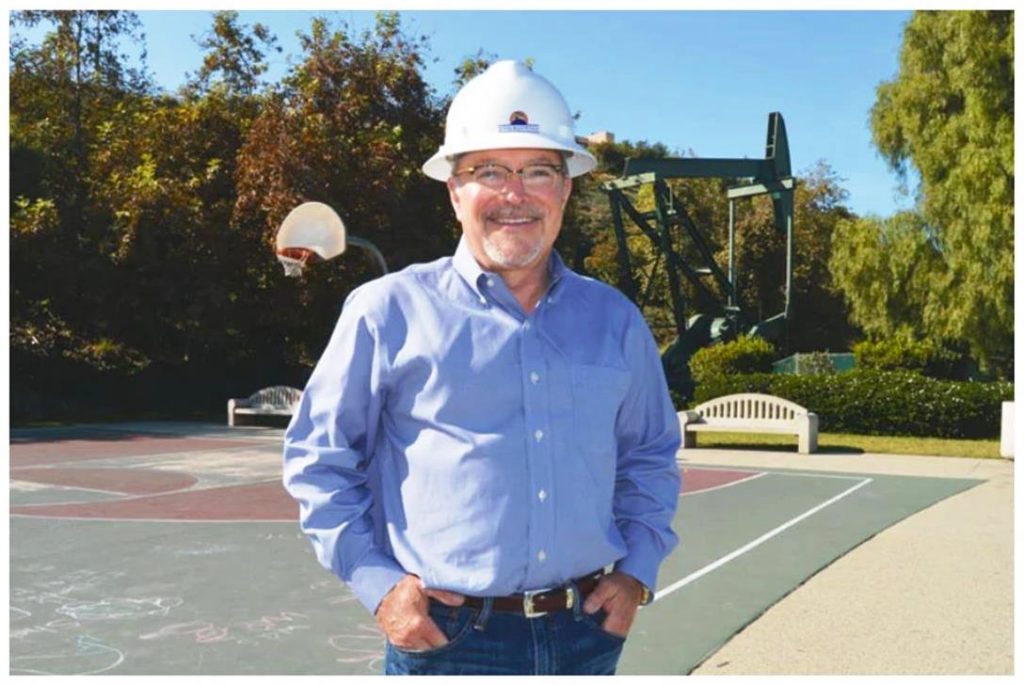
Pictured from left: Richie Diaz, rig hand; Pat Hurley, drilling coordinator; Steve Clavijo, rig hand; and David Slater, Executive VP and COO. (Photograph by the Business Journal’s Brandon Richardson)
The Long Beach Business Journal recently published their annual Focus on Signal Hill. David Slater, Executive VP and COO for SHP was interviewed about the current status of the oil industry and how business has been in Signal Hill over the last year.
“Our oil and gas business has been very robust this year. When we have strong cash flow, we reinvest in the infrastructure for our business,” Slater said. “We’ve been busy primarily upgrading and replacing our surface facility equipment like pipelines and tanks. We are working to bring one of our two drilling rigs out of mothballs and we anticipate drilling some new wells in the fourth quarter.” At this time, Slater said the company has plans to drill two or three wells this year.”
To read the entire article click on the link below.
Higher Oil Prices Means More Investment And Drilling Coming To Signal Hill
The Long Beach Business Journal published their annual focus on the oil and gas industry issue. David Slater, Executive VP and COO for SHP was interviewed about the current status and hopes for the future for the oil and gas industry. In addition to how the industry is stabilizing and preparing for the future, Slater specifically focused on SHP’s operations and mindset:
“We consider our primary mission to be stewards of our community and stewards of the environment. The safety of our personnel and the safety of the public is paramount to our company,” Slater explained. “We’re very proud of our track record but that doesn’t mean that we can’t improve. That’s the attitude of our company: get better every day.”
To read the entire article click on the link below.
Oil and Gas Experts Are ‘Cautiously Optimistic’
The Long Beach Business Journal published their annual Focus on Signal Hill edition. The earlier post was about SHP’s contributions to the city as an energy producer, but the article below is about SHP’s unique position to help develop the future landscape of Signal Hill. As one of the largest land owners in Signal Hill, SHP is looking forward to developing our vacant lots into something special for the city. Continue reading below for details about the upcoming SHP development project, Heritage Square.
Numerous Developments To Alter Signal Hill Landscape
The City of Signal Hill is in the midst of a development surge – affordable and market rate housing, for-sale homes, retail, parks and mixed use projects. One of the most notable projects in the works is Signal Hill Petroleum’s (SHP) Heritage Square.
“The site plan has advanced significantly in the last two months,” Dave Slater, Signal Hill Petroleum chief operating officer and executive vice president, said. “We’re looking at a Class A apartment, residential, multi-family building, in addition to restaurant space and bringing in a very high-quality boutique grocer, Mother’s Market.”
The project is located on the northwest corner of Cherry Avenue and Burnett Street and is currently being negotiated between the city and SHP. Slater said the company has identified a high-end restaurant operator, which he hopes will open a signature restaurant with a great view at the project.

Signal Hill Petroleum’s Heritage Square Development is designed to be an urban village. The project features about 200 Class A apartment units with amenities, boutique grocery store Mother’s Market, a high-end restaurant and open gathering space. Located on the northwest corner of Cherry Avenue and Burnett Street, the project is nearing the end of its design phase. (Rendering courtesy of Signal Hill Petroleum)
“We’re really looking to create an urban village, Main Street atmosphere. And the site design we’ve got on the table now, I think we’re very close to having fine-tuned it,” Slater said. “I think the site plan is really exciting, and I think we’re going to deliver a real quality project – lots of open space, gathering space, kind of unique and eclectic retail spaces, a mix of restaurant uses.”
A key feature to the Heritage Square project is the inclusion of about 200 residential units. Slater described the housing element as a Class A, multi-floor, residential building that will feature amenities to appeal to a population not present in Signal Hill. The residential component is important because Slater said it brings in a customer base for the new urban village businesses.
The Heritage Square project will be very pedestrian friendly, according to Slater, with an open plaza serving as a destination and connection point for the city’s extensive walking and hiking trail system.
To read the entire article click here
The Long Beach Business Journal published their annual Focus on Signal Hill edition stating that “With Numerous Projects Underway And A Balanced Budget, City Officials Optimistic About The Future […] Smack-dab in the middle of Long Beach sits the 2.2-square-mile City of Signal Hill. Considering its size, the old oil town is undergoing massive amounts of development, with three residential projects underway and one more in the works, as well as plans for two parks and a new 12,000-square-foot public library. On top of booming development, the city is well positioned financially.” For entire article continuing reading below.
Focus on Signal Hill
July 17, 2017 Brandon Richardson, Senior Writer
With Numerous Projects Underway And A Balanced Budget, City Officials Optimistic About The Future
Volatile Oil Prices Keep Well Drilling On Hold
Even though it’s not covered in oil derricks as it was in years long passed, Signal Hill still produces its fair share of oil through Signal Hill Petroleum (SHP). However, continuously low oil prices have put a stop to the company’s drilling activities.
“Our oil production is stable, but based on where current oil prices are, we are delaying our plans for more significant reinvestment,” David Slater, SHP chief operating officer and executive vice president, said. “We do have projects planned. We’d just like to see a little bit better margin before we make that capital commitment.”
Slater said the industry saw a sag in prices recently, down to around $44 per barrel from $50 per barrel a short time ago, according to the West Texas Intermediate benchmark. He explained that the current market is very volatile, with price swings between $10 and $12.

David Slater, chief operating officer and executive vice president of Signal Hill Petroleum, said discretionary spending is at a minimum due to low and volatile oil prices, which means all drilling operations are on hold. He said he is optimistic that drilling activity can resume in the next six months or so. (Photograph by the Business Journal’s Larry Duncan)
Despite market volatility, Signal Hill Petroleum’s more than 400 wells continue to produce approximately 1 million barrels of oil per year, which comes out to more than 2,700 barrels per day.
During times of moderate gas prices, Slater said when discretionary spending is low and the company’s two drilling rigs are mothballed, SPH focuses on its infrastructure to ensure it continues to operate in a neighborhood-friendly manner. As a member of a small community, Slater said this is important for the company’s relationship with residents living near active wells.
The company is continuously working to maintain pipelines, tanks, pumps and all other infrastructure to ensure their capability when drilling activities resume. Signal Hill Petroleum is also a prominent landowner and developer in Signal Hill, which helps offset low oil prices.
The City of Signal Hill taxes each barrel of oil produced in the city, which generated $1.1 million in tax revenue during the 2015-2016 fiscal year. However, with the drop in oil prices and halting of drilling operations, tax revenue has been cut by almost half.
Despite the freeze on drilling operations, Slater noted that the Long Beach Oil Field – a super giant, meaning it has produced over 1 billion barrels of oil – still has plenty of oil for the urban oil company to tap into, hopefully in the near future.
“But we’re optimistic that we’re going to be reinvesting and having drilling activity in the next six months or so,” Slater said. “There’s a lot of oil and gas opportunity. The life of the oil and gas field has got a long, long way to go. And there’s still a lot of oil to be produced and a lot of wells still to be drilled.”
The Long Beach Business Journal published an article, Economic Outlook Oil and Gas: Despite Opportunities To Be Energy Independent, California Is Importing Two-Thirds Of Its Oil, which explains the challenges faced by the California Oil industry while trying to provide California with energy independence.
David Slater, Executive Vice President and COO for SHP states, “Our pitch is always, we need the energy and the access. The clean, affordable energy is what differentiates our society from a lot of other places in the world,” Slater said. “And it is just an all-around winner if we could just produce that energy right here in our own backyard.” For the complete article continue reading below.
Economic Outlook Oil and Gas: Despite Opportunities To Be Energy Independent, California Is Importing Two-Thirds Of Its Oil
July 5, 2017, Brandon Richardson, Senior Writer
The oil and gas industry is a leading economic driver and major employer in the State of California, creating more than 368,000 jobs, according to a June report by the Western States Petroleum Association. The report also states that the industry produces $33 billion in labor income, $148 billion in total economic output and more than $50 billion in local, state and federal taxes.
Oil
While oil-drilling activity has increased dramatically nationwide, according to Bob Barnes, executive vice president of operations for California Resources Corporation, activity in California remains low.
“California has been the third-largest oil producing state for decades, but domestic statewide production levels are decreasing,” Barnes said. “At a time when our state is embracing the mantle of environmental leadership for America, California is missing an opportunity to be a shining example that a state or country can achieve energy self-sufficiency while applying the most stringent standards in the world.”
Instead, Barnes explained that California is becoming increasingly dependent on oil produced in areas with lesser environmental, labor, human rights and safety standards. In 2016, Barnes said California imported a record 67% of its oil from other countries and Alaska to meet the ever-increasing demand.
The growing dependence means California’s working families are subsidizing energy development, jobs and taxes in other states and foreign countries, according to Barnes.
“In an ever-changing and uncertain world, increasing California’s energy supply is the best way to ensure that all Californians have access to affordable and reliable energy,” Barnes said. “Our mantra is ‘Energy for California by Californians,’ and we are dedicated to ensuring that California has a vibrant and sustainable future by all measures – environmental, economic and social.”
Catherine Reheis-Boyd, president of the Western States Petroleum Association, said that while the prominent political atmosphere in California is promoting a well-funded off-oil agenda, residents in the state consume approximately 2 million gallons of gasoline and diesel fuel per hour. According to the California Department of Motor Vehicles, as of December 2016, there were about 32 million registered vehicles on the road.
California oil producers must be more calculating when it comes to exploration and drilling activity due to stringent regulation. Reheis-Boyd explained that it is a major challenge to comply with state regulations and still remain competitive in the open market.
The fees associated with the oil industry are not restricted to producers, Reheis-Boyd noted, but are also felt by consumers at the pumps. Prior to Senate Bill 1, the cost of gasoline included 74.83 cents per gallon and the cost of diesel included 82.71 cents per gallon in taxes for low carbon fuel standard, cap and trade, underground storage tanks, and state and federal taxes. Beginning November 1, SB 1 increases gasoline tax by 12 cents per gallon and diesel tax by 20 cents per gallon for road maintenance and rehabilitation.
According to Reheis-Boyd, there are opportunities in the state to ramp up exploration and production, which would mean less imported oil brought in on tankers and trains, thereby reducing emissions harmful to the environment.
“So we would love to do more exploration and production in California if the regulatory environment would allow us,” Reheis-Boyd said. “I’m not going to say that it’s just the regulations, because one of the biggest factors for producing crude oil is the price you get for it when you sell it.”
Currently, oil prices are in the low $40 range, according to David Slater, executive vice president and chief operating officer of Signal Hill Petroleum (SHP). Slater said that for SHP, current prices mean they can maintain current operations and remain profitable, but both the company’s drilling rigs have been mothballed for the time being.
“We’re definitely in a lower activity mode as far as discretionary spending,” Slater said. “But we’re maintaining our high-caliber operations and keeping our focus on safety and keeping a focus on being environmental and neighbor friendly.”
While SHP’s and other California companies’ activities are low, Slater said that United States production has essentially doubled with recent drilling of shale plays in Texas and other states. This introduction of millions more barrels of oil per day into a full market is what is creating price volatility, which Slater said is likely to continue through the year.
Slater said he hopes prices at least swing up into the low $50 range so that California companies can begin ramping up activity to help meet the demands of residents.
“Our pitch is always, we need the energy and the access. The clean, affordable energy is what differentiates our society from a lot of other places in the world,” Slater said. “And it is just an all-around winner if we could just produce that energy right here in our own backyard.” […]

 Download Whitepaper
Download Whitepaper
